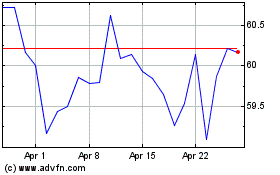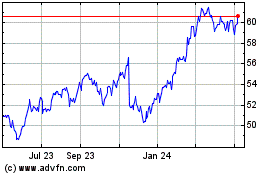By Sarah Nassauer
Walmart Inc. said it would raise wages for about 425,000 of its
employees after a year in which the Covid-19 pandemic boosted its
business and demand for workers who handle online orders.
The company reported strong holiday sales but predicted slower
growth and higher spending this year. After surging last year, the
company's stock fell 6% in trading Thursday.
Congress is debating whether to raise the federal minimum wage
from $7.25 an hour. The Biden administration's proposal, part of a
Covid-19 stimulus relief package, seeks to increase it to $15 over
four years.
Walmart Chief Executive Doug McMillon said the company supports
raising the federal minimum but there are parts of the country that
should be lower than others, and increases should be paced out. The
company is keeping its starting wage at $11 an hour.
"You want that beginning rung of that ladder to be in the right
place for the market to ensure that you can, and small businesses
as well, can get people into the workforce," Walmart's Chief
Financial Officer Brett Biggs said in an interview.
The country's largest private employer said its more-targeted
raises would increase pay for its hourly U.S. workers to an average
above $15 an hour, up from an average above $14 in January 2020.
Walmart employs about 1.5 million hourly U.S. workers and 2.2
million people world-wide.
Walmart has been competing with Amazon.com Inc. and others for
warehouse workers and other staff that are handling a surge in
online orders during the pandemic. Amazon raised its starting U.S.
wage to $15 an hour in 2018 and hired 500,000 people last year to
bring its global workforce to 1.3 million. Both companies also
doled out bonuses to many of their staffers last year.
The pay raises will be for store workers in digital and stocking
roles, said Walmart U.S. Chief Executive John Furner. That targets
roles that have been especially important during the pandemic,
including workers that gather products from store shelves for
online orders picked up in parking lots or delivered to homes.
Walmart has worked to keep shelves stocked as shoppers stockpile
certain items such as food and cleaning supplies.
"We saw major changes to customer behavior last year we believe
will be lasting, and we have to continue working to stay in-stock,
deliver items on time and provide the best omni experience
possible," said Mr. Furner.
Starting March 13, pay for workers in those roles will move up
to $13 to $19 an hour, based on a store's location.
Smaller rivals Target Corp. and Best Buy Co. last year made $15
an hour their starting wage for all workers.
Walmart workers who receive the latest raises will no longer get
a quarterly bonus after the first quarter of this year, according
to documents viewed by the Journal. That is similar to bonus
elimination Walmart implemented for about 165,000 workers who got
pay raises last year.
"The overwhelming majority of our associates say their hourly
wages are the most important part of their pay," said a Walmart
spokeswoman. A regular raise instead of a bonus offers workers more
predictability in their pay, she said.
Average hourly earnings for nonsupervisory retail workers in the
U.S. was $18.17 an hour in January, according to the Labor
Department. The average wage was up from $16.92 an hour a year
earlier. Economists attribute at least part of the increase to
lower-wage workers losing their jobs during the pandemic. The
sector employed nearly 400,000 fewer workers in January than a year
earlier.
Walmart's sales rose during the fourth quarter due to strong
holiday shopping, with an additional boost when U.S. stimulus
checks arrived in January, Walmart said. Food sales went up as the
quarter progressed, the company said.
U.S. comparable sales, or those from stores and digital channels
operating for at least 12 months, rose 8.6% in the quarter ended
Jan. 29, an acceleration from the third quarter, when sales climbed
6.4%, and higher than most analysts' forecasts. U.S. e-commerce
sales, which include online grocery orders, increased 69% from a
year earlier.
Adjusted per-share earnings hit $1.39 during the fourth quarter,
lower than the $1.51 analysts expected, according to FactSet.
Walmart spent around $1.1 billion in the quarter on
Covid-19-related expenses such as increased pay and benefits.
The Covid-19 sales boost has allowed Walmart to accelerate
investment plans, executives said during a Thursday investor
meeting. Walmart forecast $14 billion in capital expenditures in
the current fiscal year, up from about $10 billion last year.
Those investments will focus on technology, supply chain, faster
fulfillment, automation and customer facing e-commerce efforts,
executives said. This year "has set us up to take the company where
we want to take it and do it earlier than we had planned," Mr.
Biggs said.
Walmart said it expects lower profits and slower growth in the
new fiscal year. It forecast U.S. comparable sales would rise by a
low-single-digit percentage, compared with 8.6% growth in fiscal
2021. Walmart, like many other businesses during the pandemic, had
stopped giving financial guidance in recent quarters.
Like recent quarters at Walmart, the number of shopper trips
declined but the average each spent per visit went up. Some
shoppers have avoided stores for health reasons, but are making the
most of each trip. During the most recent quarter, U.S. visits
declined 10.9%, while the average amount spent went up 21.9%.
Walmart's total revenue reached a record $152.1 billion in the
fourth quarter, an increase of 10.3% from a year ago, and its
operating income rose 3% to $5.5 billion. The company reported a
quarterly net loss of $2.1 billion, reflecting hefty losses tied to
the pending sales of its U.K. and Japanese operations.
--Eric Morath contributed to this article.
Write to Sarah Nassauer at sarah.nassauer@wsj.com
(END) Dow Jones Newswires
February 18, 2021 18:27 ET (23:27 GMT)
Copyright (c) 2021 Dow Jones & Company, Inc.
Walmart (NYSE:WMT)
Historical Stock Chart
From Jun 2024 to Jul 2024

Walmart (NYSE:WMT)
Historical Stock Chart
From Jul 2023 to Jul 2024
